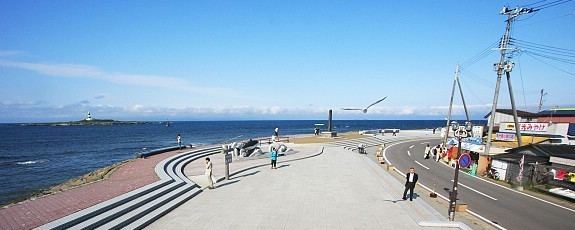Country Japan District Shimokita - Flower Rosa rugosa Population 5,521 (28 Feb 2017) Local time Monday 1:33 AM | Region Tōhoku - Tree Japanese black pine Area 52.06 km² Prefecture Aomori Prefecture | |
 | ||
Time zone Japan Standard Time (UTC+9) Weather 5°C, Wind SW at 21 km/h, 86% Humidity | ||
Ōma (大間町, Ōma-machi) is a town located in the Shimokita District of northeastern Aomori in the Tōhoku region of northern Japan. As of 28 February 2017, the town had an estimated population of 5,581 and a population density of 107.2 persons per km2, in 2542 households. Its total area was 52.06 square kilometres (20.10 sq mi).
Contents
- Map of Oma Shimokita District Aomori Prefecture Japan
- Geography
- Neighbouring municipalities
- Demographics
- History
- Economy
- Education
- Railway
- Highway
- Local attractions
- In Japan
- Overseas
- Noted people from ma
- References
Map of Oma, Shimokita District, Aomori Prefecture, Japan
Geography
Ōma occupies the northwestern coastline of Shimokita Peninsula, facing the Tsugaru Strait. Cape Ōmazaki (大間崎) is the northernmost point on the island of Honshū. The town has a climate characterized by cool short summers and long cold winters with strong winds (Köppen climate classification Cfa). The average annual temperature in Ōma is 9.5 °C. The average annual rainfall is 1205 mm with September as the wettest month.The temperatures are highest on average in August, at around 22.3 °C, and lowest in January, at around -1.8 °C.
Much of the town is within the limits of the Shimokita Hanto Quasi-National Park. In the year 2002, the Ministry of the Enviroment classified some tidal flats of the Ōma shoreline to be one of the 500 Important Wetlands in Japan particularly for its biodiversity of marine flora, especially several varieties of kelp
Neighbouring municipalities
Demographics
Per Japanese census data, the population of Ōma has declined over the past 40 years.
History
The area around Ōma was inhabited by the Emishi people until the historical period. During the Edo period, it was controlled by the Nambu clan of Morioka Domain. During the post-Meiji restoration cadastral reform of 1889, Ōoku Village was proclaimed from the merger of Ōma hamlet with neighboring Okudo hamlet. It was renamed Ōma Town on November 3, 1942.
Ōma has been a popular location setting for movies and television dramas. It was the setting for the 1983 movie Gyōei no mure (魚影の群れ) starring Ken Ogata. In 2000, Ōma was the setting for an NHK television series Watashi no Aoi Sora (私の青空) starring Tabata Tomoko. This was followed by another fictional series Maguro (マグロ) on TV Asahi starring Tetsuya Watari in 2007.
Economy
The economy of Ōma was traditionally heavily dependent on commercial fishing. The town was famous for its tuna, which was caught in the traditional manner by hand in two-person boats, and sold under the “Ōma” registered trademark. Other seafood products include sea urchin roe, konbu and squid.
The town is also the site of a nuclear power plant, the Ōma Nuclear Power Plant, which will be unique in its use of MOX fuel when it comes on line.
Education
Ōma has two public elementary schools and two public middle schools operated by the town government, and one public high school operated by the Aomori Prefectural Board of Education.
